University: Customer Satisfaction Enhancement with ERP Systems
VerifiedAdded on 2022/09/17
|14
|3506
|23
Essay
AI Summary
This essay explores the implementation and impact of Enterprise Resource Planning (ERP) systems on customer satisfaction. It highlights how ERP, built on platforms like Oracle Fusion and SAP NetWeaver, enhances customer satisfaction by improving data integration, automating business processes through CRM and SCM, and ensuring data security. The essay emphasizes the importance of customer satisfaction in modern business and discusses the benefits of ERP, including accurate order delivery, improved accessibility, better customization, enhanced customer service, and secure data management. It examines how ERP streamlines business processes, matches supply with demand, and improves user experience, ultimately increasing profitability and customer retention. While acknowledging the benefits, the essay also addresses the challenges of ERP implementation, such as high costs, implementation complexities, and potential data risks. The essay concludes by emphasizing the role of ERP in building strong customer relationships and fostering business growth. The essay is based on the INF60012 course, which is a critical review essay that explores some aspect of enterprise systems.
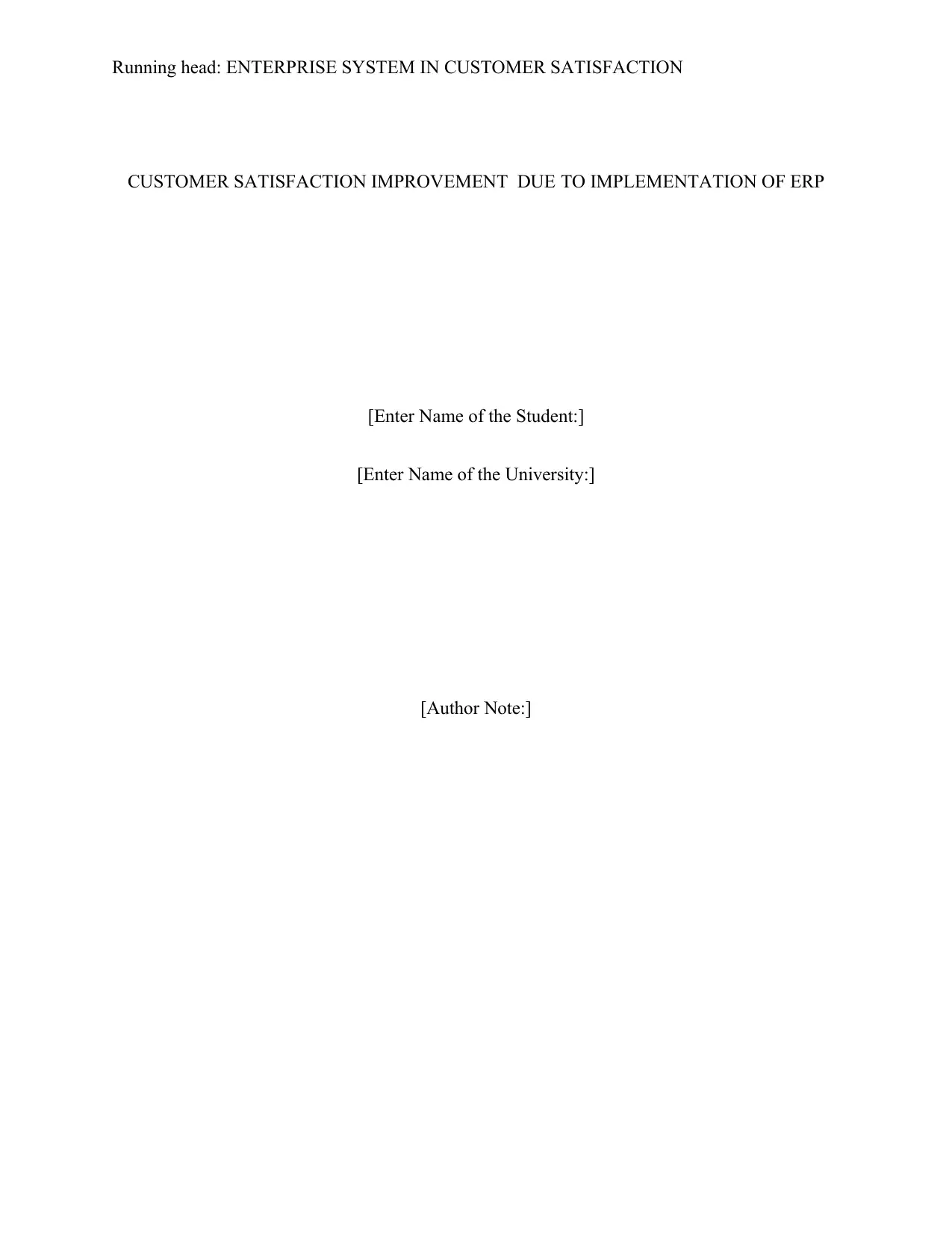
Running head: ENTERPRISE SYSTEM IN CUSTOMER SATISFACTION
CUSTOMER SATISFACTION IMPROVEMENT DUE TO IMPLEMENTATION OF ERP
[Enter Name of the Student:]
[Enter Name of the University:]
[Author Note:]
CUSTOMER SATISFACTION IMPROVEMENT DUE TO IMPLEMENTATION OF ERP
[Enter Name of the Student:]
[Enter Name of the University:]
[Author Note:]
Paraphrase This Document
Need a fresh take? Get an instant paraphrase of this document with our AI Paraphraser
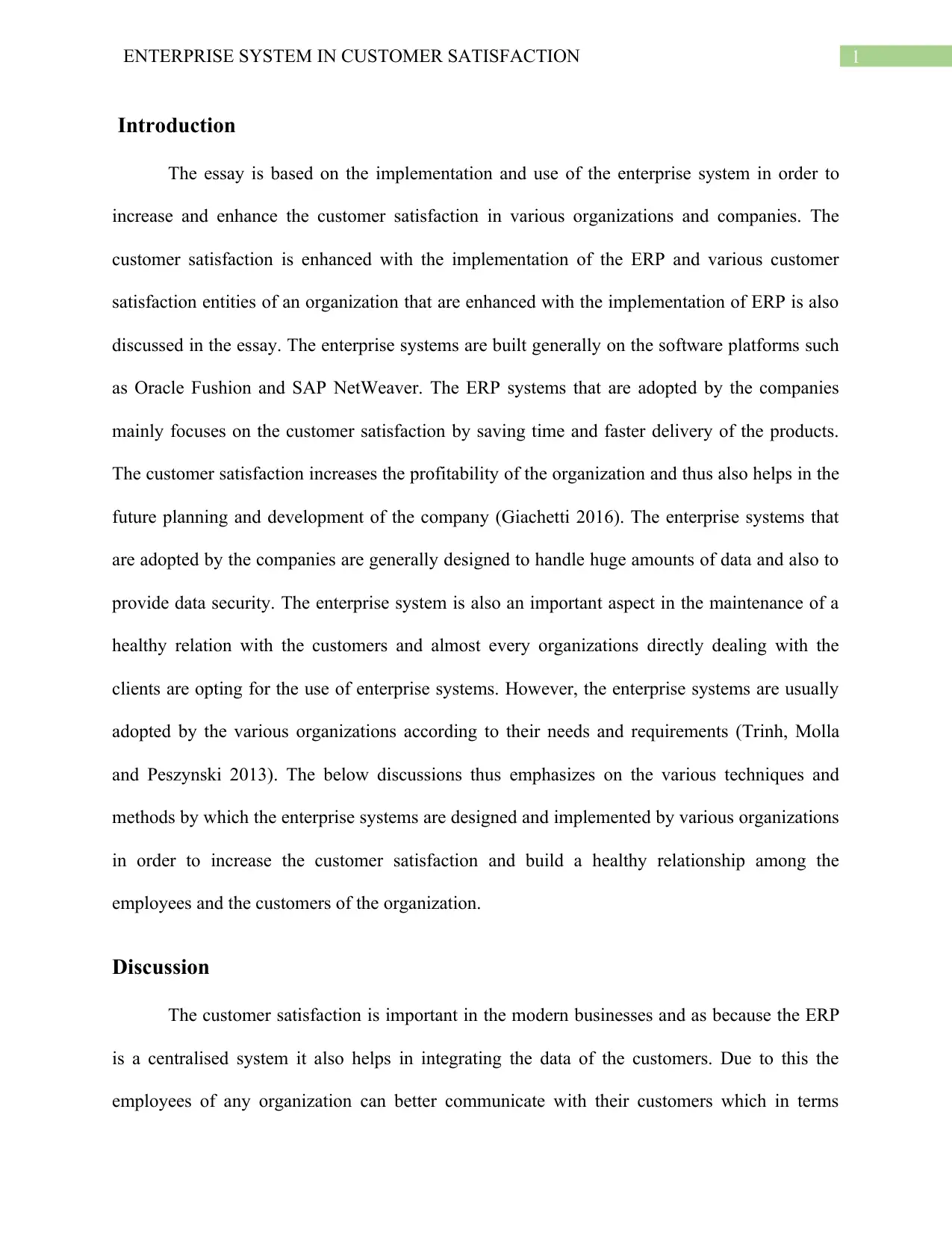
1ENTERPRISE SYSTEM IN CUSTOMER SATISFACTION
Introduction
The essay is based on the implementation and use of the enterprise system in order to
increase and enhance the customer satisfaction in various organizations and companies. The
customer satisfaction is enhanced with the implementation of the ERP and various customer
satisfaction entities of an organization that are enhanced with the implementation of ERP is also
discussed in the essay. The enterprise systems are built generally on the software platforms such
as Oracle Fushion and SAP NetWeaver. The ERP systems that are adopted by the companies
mainly focuses on the customer satisfaction by saving time and faster delivery of the products.
The customer satisfaction increases the profitability of the organization and thus also helps in the
future planning and development of the company (Giachetti 2016). The enterprise systems that
are adopted by the companies are generally designed to handle huge amounts of data and also to
provide data security. The enterprise system is also an important aspect in the maintenance of a
healthy relation with the customers and almost every organizations directly dealing with the
clients are opting for the use of enterprise systems. However, the enterprise systems are usually
adopted by the various organizations according to their needs and requirements (Trinh, Molla
and Peszynski 2013). The below discussions thus emphasizes on the various techniques and
methods by which the enterprise systems are designed and implemented by various organizations
in order to increase the customer satisfaction and build a healthy relationship among the
employees and the customers of the organization.
Discussion
The customer satisfaction is important in the modern businesses and as because the ERP
is a centralised system it also helps in integrating the data of the customers. Due to this the
employees of any organization can better communicate with their customers which in terms
Introduction
The essay is based on the implementation and use of the enterprise system in order to
increase and enhance the customer satisfaction in various organizations and companies. The
customer satisfaction is enhanced with the implementation of the ERP and various customer
satisfaction entities of an organization that are enhanced with the implementation of ERP is also
discussed in the essay. The enterprise systems are built generally on the software platforms such
as Oracle Fushion and SAP NetWeaver. The ERP systems that are adopted by the companies
mainly focuses on the customer satisfaction by saving time and faster delivery of the products.
The customer satisfaction increases the profitability of the organization and thus also helps in the
future planning and development of the company (Giachetti 2016). The enterprise systems that
are adopted by the companies are generally designed to handle huge amounts of data and also to
provide data security. The enterprise system is also an important aspect in the maintenance of a
healthy relation with the customers and almost every organizations directly dealing with the
clients are opting for the use of enterprise systems. However, the enterprise systems are usually
adopted by the various organizations according to their needs and requirements (Trinh, Molla
and Peszynski 2013). The below discussions thus emphasizes on the various techniques and
methods by which the enterprise systems are designed and implemented by various organizations
in order to increase the customer satisfaction and build a healthy relationship among the
employees and the customers of the organization.
Discussion
The customer satisfaction is important in the modern businesses and as because the ERP
is a centralised system it also helps in integrating the data of the customers. Due to this the
employees of any organization can better communicate with their customers which in terms
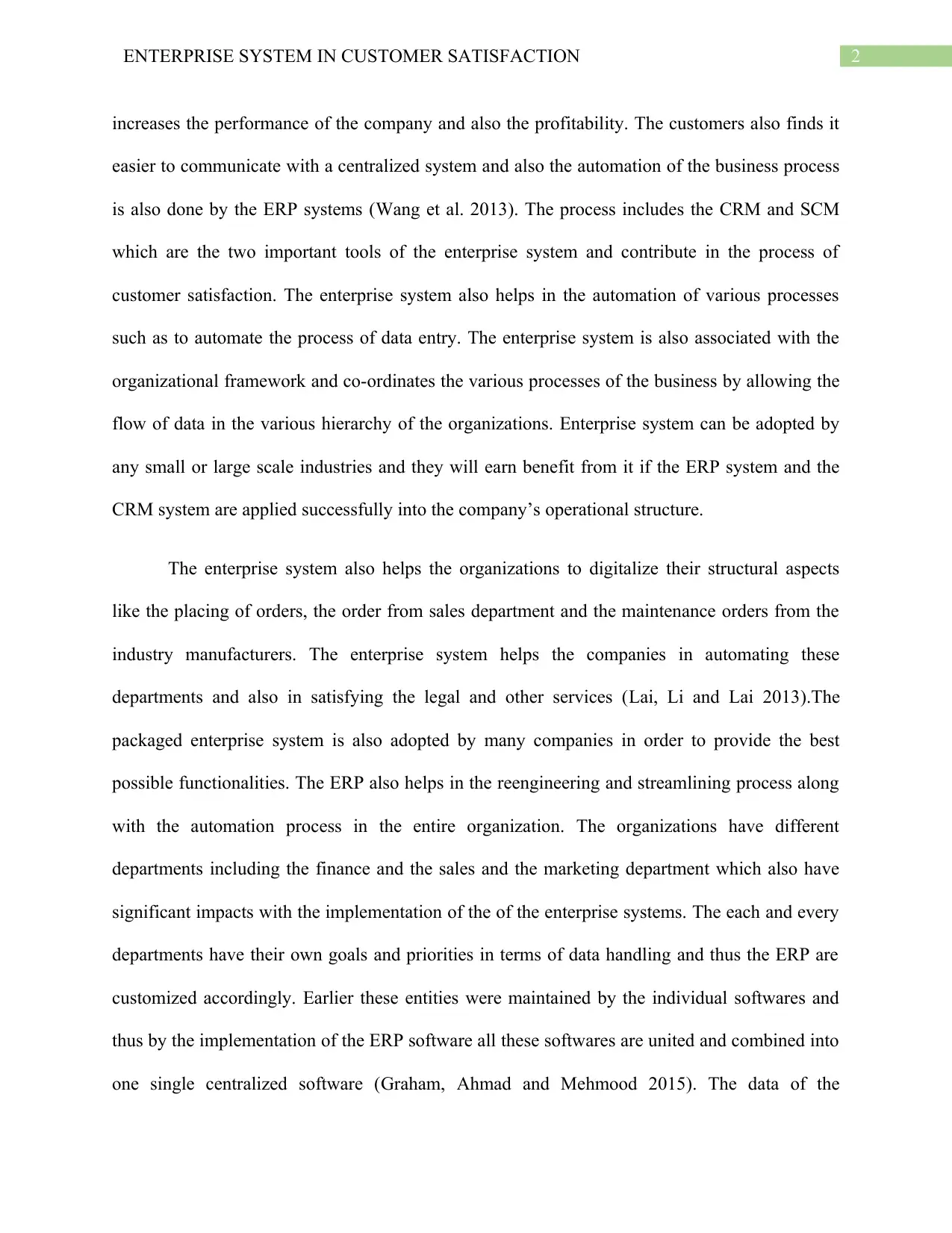
2ENTERPRISE SYSTEM IN CUSTOMER SATISFACTION
increases the performance of the company and also the profitability. The customers also finds it
easier to communicate with a centralized system and also the automation of the business process
is also done by the ERP systems (Wang et al. 2013). The process includes the CRM and SCM
which are the two important tools of the enterprise system and contribute in the process of
customer satisfaction. The enterprise system also helps in the automation of various processes
such as to automate the process of data entry. The enterprise system is also associated with the
organizational framework and co-ordinates the various processes of the business by allowing the
flow of data in the various hierarchy of the organizations. Enterprise system can be adopted by
any small or large scale industries and they will earn benefit from it if the ERP system and the
CRM system are applied successfully into the company’s operational structure.
The enterprise system also helps the organizations to digitalize their structural aspects
like the placing of orders, the order from sales department and the maintenance orders from the
industry manufacturers. The enterprise system helps the companies in automating these
departments and also in satisfying the legal and other services (Lai, Li and Lai 2013).The
packaged enterprise system is also adopted by many companies in order to provide the best
possible functionalities. The ERP also helps in the reengineering and streamlining process along
with the automation process in the entire organization. The organizations have different
departments including the finance and the sales and the marketing department which also have
significant impacts with the implementation of the of the enterprise systems. The each and every
departments have their own goals and priorities in terms of data handling and thus the ERP are
customized accordingly. Earlier these entities were maintained by the individual softwares and
thus by the implementation of the ERP software all these softwares are united and combined into
one single centralized software (Graham, Ahmad and Mehmood 2015). The data of the
increases the performance of the company and also the profitability. The customers also finds it
easier to communicate with a centralized system and also the automation of the business process
is also done by the ERP systems (Wang et al. 2013). The process includes the CRM and SCM
which are the two important tools of the enterprise system and contribute in the process of
customer satisfaction. The enterprise system also helps in the automation of various processes
such as to automate the process of data entry. The enterprise system is also associated with the
organizational framework and co-ordinates the various processes of the business by allowing the
flow of data in the various hierarchy of the organizations. Enterprise system can be adopted by
any small or large scale industries and they will earn benefit from it if the ERP system and the
CRM system are applied successfully into the company’s operational structure.
The enterprise system also helps the organizations to digitalize their structural aspects
like the placing of orders, the order from sales department and the maintenance orders from the
industry manufacturers. The enterprise system helps the companies in automating these
departments and also in satisfying the legal and other services (Lai, Li and Lai 2013).The
packaged enterprise system is also adopted by many companies in order to provide the best
possible functionalities. The ERP also helps in the reengineering and streamlining process along
with the automation process in the entire organization. The organizations have different
departments including the finance and the sales and the marketing department which also have
significant impacts with the implementation of the of the enterprise systems. The each and every
departments have their own goals and priorities in terms of data handling and thus the ERP are
customized accordingly. Earlier these entities were maintained by the individual softwares and
thus by the implementation of the ERP software all these softwares are united and combined into
one single centralized software (Graham, Ahmad and Mehmood 2015). The data of the
⊘ This is a preview!⊘
Do you want full access?
Subscribe today to unlock all pages.

Trusted by 1+ million students worldwide
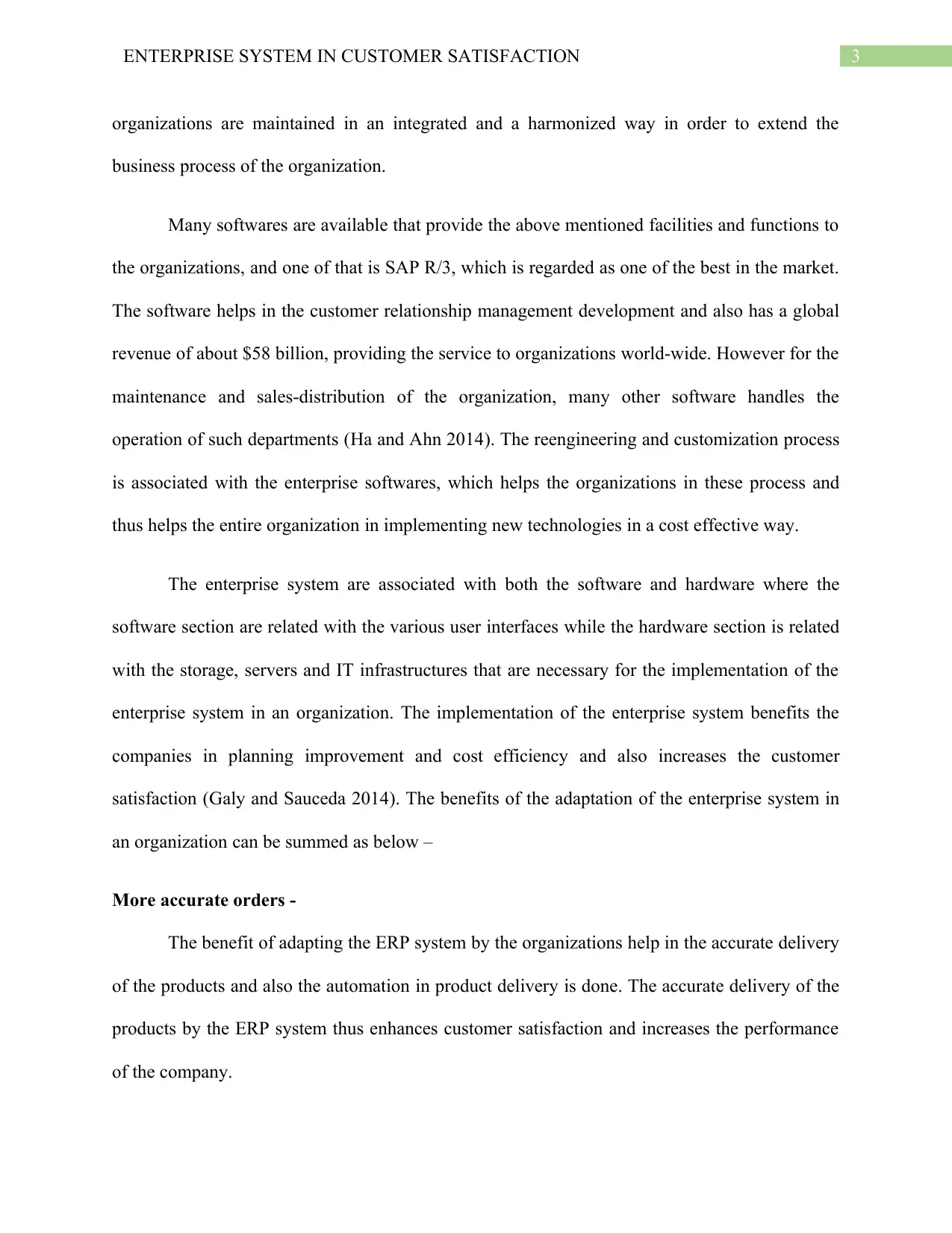
3ENTERPRISE SYSTEM IN CUSTOMER SATISFACTION
organizations are maintained in an integrated and a harmonized way in order to extend the
business process of the organization.
Many softwares are available that provide the above mentioned facilities and functions to
the organizations, and one of that is SAP R/3, which is regarded as one of the best in the market.
The software helps in the customer relationship management development and also has a global
revenue of about $58 billion, providing the service to organizations world-wide. However for the
maintenance and sales-distribution of the organization, many other software handles the
operation of such departments (Ha and Ahn 2014). The reengineering and customization process
is associated with the enterprise softwares, which helps the organizations in these process and
thus helps the entire organization in implementing new technologies in a cost effective way.
The enterprise system are associated with both the software and hardware where the
software section are related with the various user interfaces while the hardware section is related
with the storage, servers and IT infrastructures that are necessary for the implementation of the
enterprise system in an organization. The implementation of the enterprise system benefits the
companies in planning improvement and cost efficiency and also increases the customer
satisfaction (Galy and Sauceda 2014). The benefits of the adaptation of the enterprise system in
an organization can be summed as below –
More accurate orders -
The benefit of adapting the ERP system by the organizations help in the accurate delivery
of the products and also the automation in product delivery is done. The accurate delivery of the
products by the ERP system thus enhances customer satisfaction and increases the performance
of the company.
organizations are maintained in an integrated and a harmonized way in order to extend the
business process of the organization.
Many softwares are available that provide the above mentioned facilities and functions to
the organizations, and one of that is SAP R/3, which is regarded as one of the best in the market.
The software helps in the customer relationship management development and also has a global
revenue of about $58 billion, providing the service to organizations world-wide. However for the
maintenance and sales-distribution of the organization, many other software handles the
operation of such departments (Ha and Ahn 2014). The reengineering and customization process
is associated with the enterprise softwares, which helps the organizations in these process and
thus helps the entire organization in implementing new technologies in a cost effective way.
The enterprise system are associated with both the software and hardware where the
software section are related with the various user interfaces while the hardware section is related
with the storage, servers and IT infrastructures that are necessary for the implementation of the
enterprise system in an organization. The implementation of the enterprise system benefits the
companies in planning improvement and cost efficiency and also increases the customer
satisfaction (Galy and Sauceda 2014). The benefits of the adaptation of the enterprise system in
an organization can be summed as below –
More accurate orders -
The benefit of adapting the ERP system by the organizations help in the accurate delivery
of the products and also the automation in product delivery is done. The accurate delivery of the
products by the ERP system thus enhances customer satisfaction and increases the performance
of the company.
Paraphrase This Document
Need a fresh take? Get an instant paraphrase of this document with our AI Paraphraser
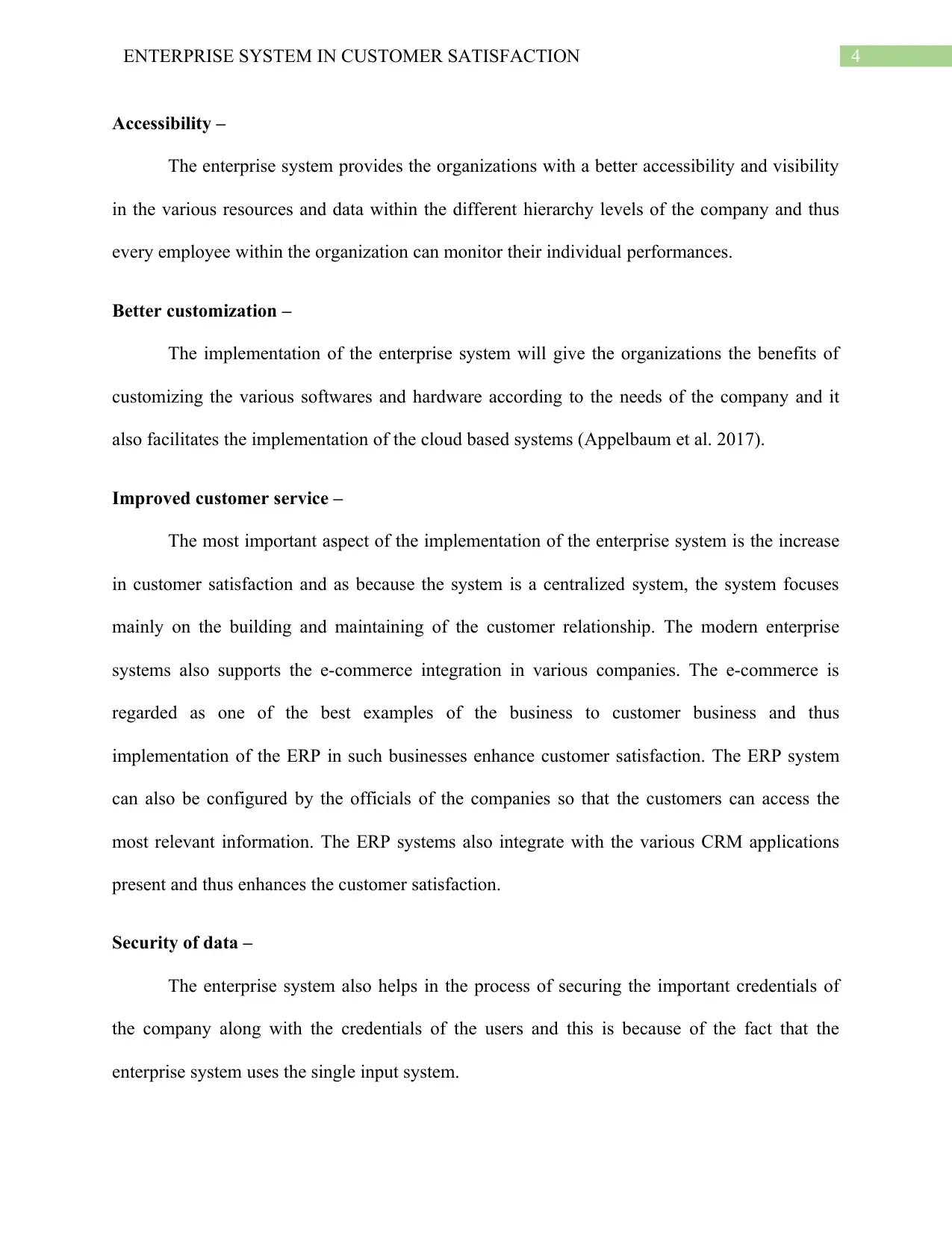
4ENTERPRISE SYSTEM IN CUSTOMER SATISFACTION
Accessibility –
The enterprise system provides the organizations with a better accessibility and visibility
in the various resources and data within the different hierarchy levels of the company and thus
every employee within the organization can monitor their individual performances.
Better customization –
The implementation of the enterprise system will give the organizations the benefits of
customizing the various softwares and hardware according to the needs of the company and it
also facilitates the implementation of the cloud based systems (Appelbaum et al. 2017).
Improved customer service –
The most important aspect of the implementation of the enterprise system is the increase
in customer satisfaction and as because the system is a centralized system, the system focuses
mainly on the building and maintaining of the customer relationship. The modern enterprise
systems also supports the e-commerce integration in various companies. The e-commerce is
regarded as one of the best examples of the business to customer business and thus
implementation of the ERP in such businesses enhance customer satisfaction. The ERP system
can also be configured by the officials of the companies so that the customers can access the
most relevant information. The ERP systems also integrate with the various CRM applications
present and thus enhances the customer satisfaction.
Security of data –
The enterprise system also helps in the process of securing the important credentials of
the company along with the credentials of the users and this is because of the fact that the
enterprise system uses the single input system.
Accessibility –
The enterprise system provides the organizations with a better accessibility and visibility
in the various resources and data within the different hierarchy levels of the company and thus
every employee within the organization can monitor their individual performances.
Better customization –
The implementation of the enterprise system will give the organizations the benefits of
customizing the various softwares and hardware according to the needs of the company and it
also facilitates the implementation of the cloud based systems (Appelbaum et al. 2017).
Improved customer service –
The most important aspect of the implementation of the enterprise system is the increase
in customer satisfaction and as because the system is a centralized system, the system focuses
mainly on the building and maintaining of the customer relationship. The modern enterprise
systems also supports the e-commerce integration in various companies. The e-commerce is
regarded as one of the best examples of the business to customer business and thus
implementation of the ERP in such businesses enhance customer satisfaction. The ERP system
can also be configured by the officials of the companies so that the customers can access the
most relevant information. The ERP systems also integrate with the various CRM applications
present and thus enhances the customer satisfaction.
Security of data –
The enterprise system also helps in the process of securing the important credentials of
the company along with the credentials of the users and this is because of the fact that the
enterprise system uses the single input system.
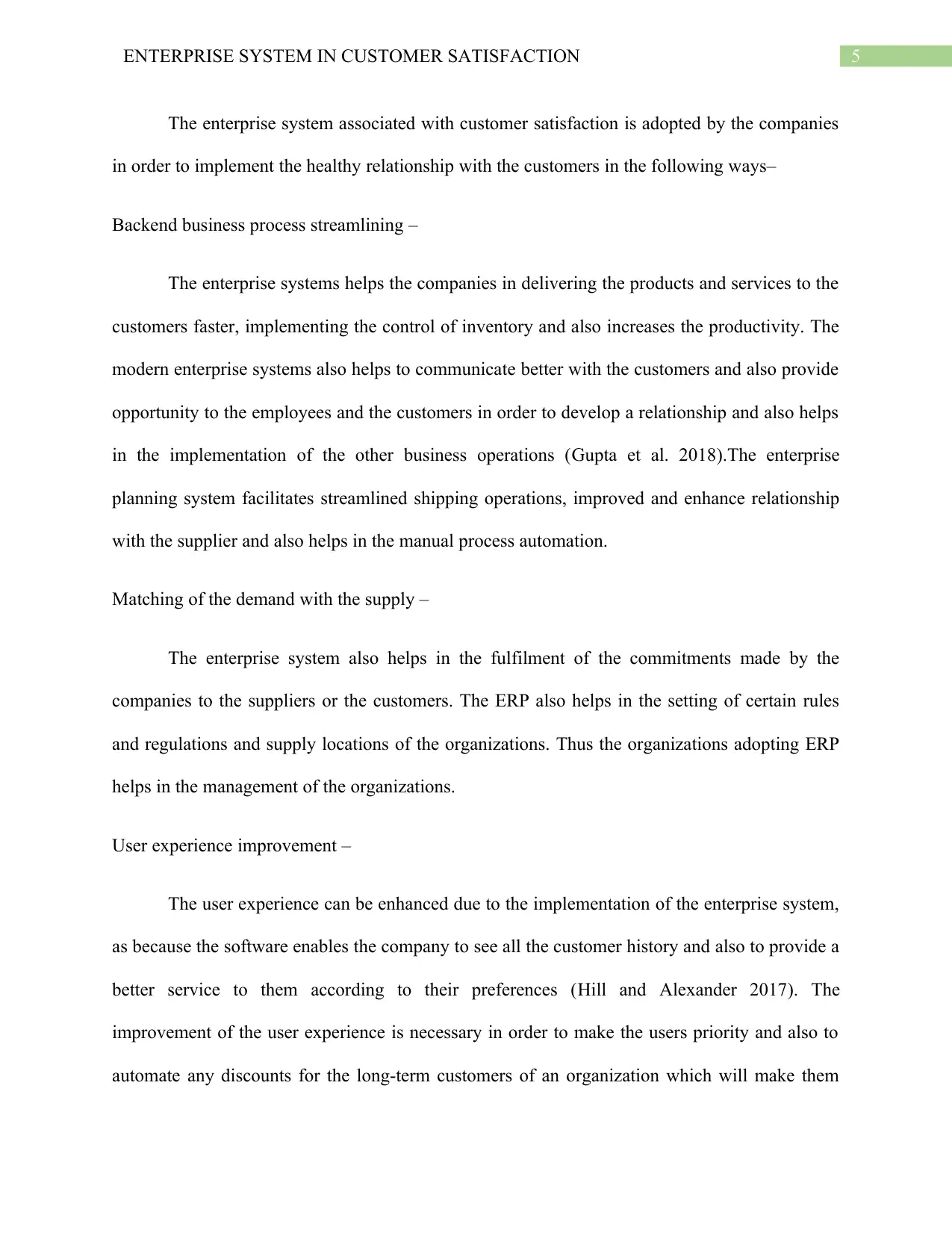
5ENTERPRISE SYSTEM IN CUSTOMER SATISFACTION
The enterprise system associated with customer satisfaction is adopted by the companies
in order to implement the healthy relationship with the customers in the following ways–
Backend business process streamlining –
The enterprise systems helps the companies in delivering the products and services to the
customers faster, implementing the control of inventory and also increases the productivity. The
modern enterprise systems also helps to communicate better with the customers and also provide
opportunity to the employees and the customers in order to develop a relationship and also helps
in the implementation of the other business operations (Gupta et al. 2018).The enterprise
planning system facilitates streamlined shipping operations, improved and enhance relationship
with the supplier and also helps in the manual process automation.
Matching of the demand with the supply –
The enterprise system also helps in the fulfilment of the commitments made by the
companies to the suppliers or the customers. The ERP also helps in the setting of certain rules
and regulations and supply locations of the organizations. Thus the organizations adopting ERP
helps in the management of the organizations.
User experience improvement –
The user experience can be enhanced due to the implementation of the enterprise system,
as because the software enables the company to see all the customer history and also to provide a
better service to them according to their preferences (Hill and Alexander 2017). The
improvement of the user experience is necessary in order to make the users priority and also to
automate any discounts for the long-term customers of an organization which will make them
The enterprise system associated with customer satisfaction is adopted by the companies
in order to implement the healthy relationship with the customers in the following ways–
Backend business process streamlining –
The enterprise systems helps the companies in delivering the products and services to the
customers faster, implementing the control of inventory and also increases the productivity. The
modern enterprise systems also helps to communicate better with the customers and also provide
opportunity to the employees and the customers in order to develop a relationship and also helps
in the implementation of the other business operations (Gupta et al. 2018).The enterprise
planning system facilitates streamlined shipping operations, improved and enhance relationship
with the supplier and also helps in the manual process automation.
Matching of the demand with the supply –
The enterprise system also helps in the fulfilment of the commitments made by the
companies to the suppliers or the customers. The ERP also helps in the setting of certain rules
and regulations and supply locations of the organizations. Thus the organizations adopting ERP
helps in the management of the organizations.
User experience improvement –
The user experience can be enhanced due to the implementation of the enterprise system,
as because the software enables the company to see all the customer history and also to provide a
better service to them according to their preferences (Hill and Alexander 2017). The
improvement of the user experience is necessary in order to make the users priority and also to
automate any discounts for the long-term customers of an organization which will make them
⊘ This is a preview!⊘
Do you want full access?
Subscribe today to unlock all pages.

Trusted by 1+ million students worldwide
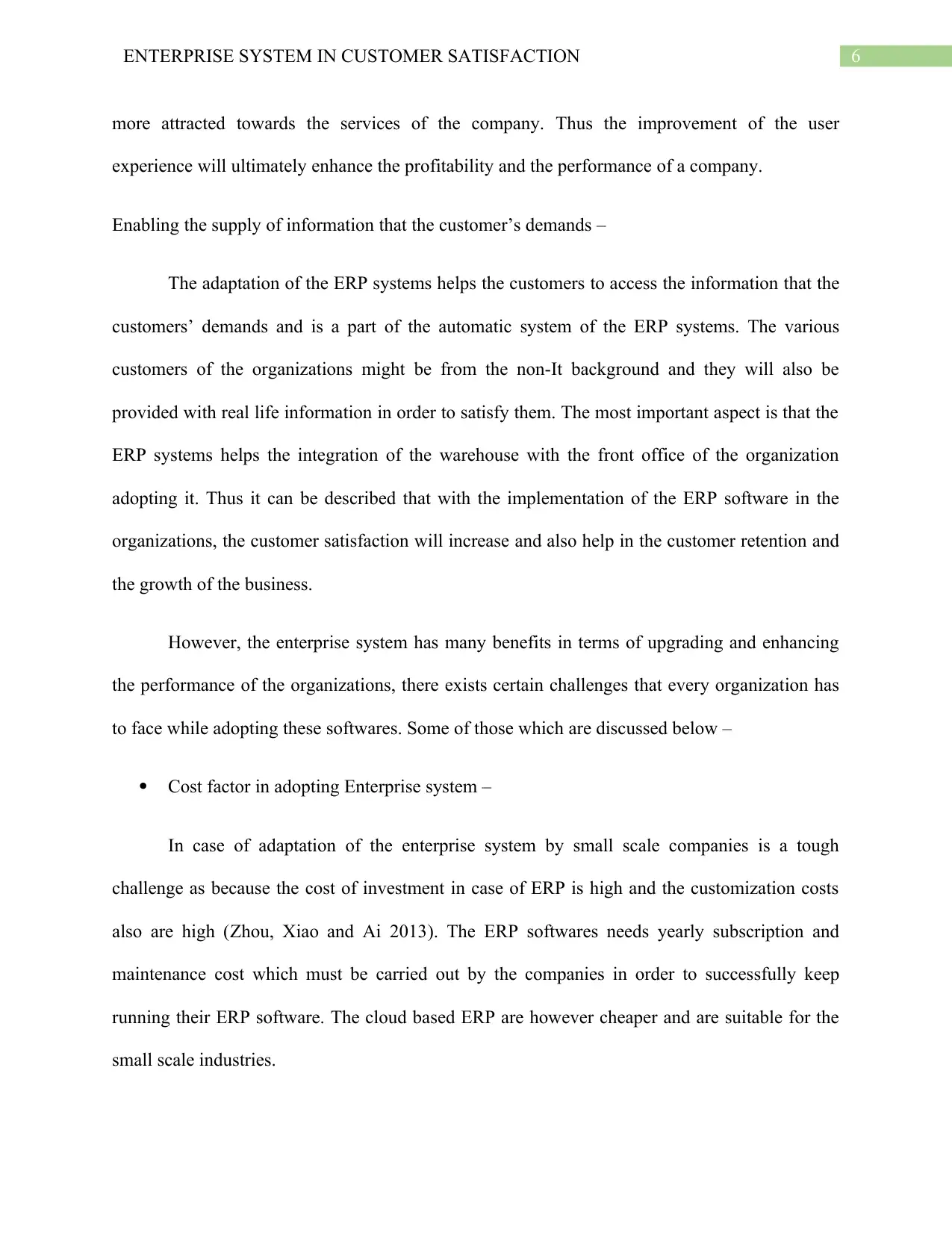
6ENTERPRISE SYSTEM IN CUSTOMER SATISFACTION
more attracted towards the services of the company. Thus the improvement of the user
experience will ultimately enhance the profitability and the performance of a company.
Enabling the supply of information that the customer’s demands –
The adaptation of the ERP systems helps the customers to access the information that the
customers’ demands and is a part of the automatic system of the ERP systems. The various
customers of the organizations might be from the non-It background and they will also be
provided with real life information in order to satisfy them. The most important aspect is that the
ERP systems helps the integration of the warehouse with the front office of the organization
adopting it. Thus it can be described that with the implementation of the ERP software in the
organizations, the customer satisfaction will increase and also help in the customer retention and
the growth of the business.
However, the enterprise system has many benefits in terms of upgrading and enhancing
the performance of the organizations, there exists certain challenges that every organization has
to face while adopting these softwares. Some of those which are discussed below –
Cost factor in adopting Enterprise system –
In case of adaptation of the enterprise system by small scale companies is a tough
challenge as because the cost of investment in case of ERP is high and the customization costs
also are high (Zhou, Xiao and Ai 2013). The ERP softwares needs yearly subscription and
maintenance cost which must be carried out by the companies in order to successfully keep
running their ERP software. The cloud based ERP are however cheaper and are suitable for the
small scale industries.
more attracted towards the services of the company. Thus the improvement of the user
experience will ultimately enhance the profitability and the performance of a company.
Enabling the supply of information that the customer’s demands –
The adaptation of the ERP systems helps the customers to access the information that the
customers’ demands and is a part of the automatic system of the ERP systems. The various
customers of the organizations might be from the non-It background and they will also be
provided with real life information in order to satisfy them. The most important aspect is that the
ERP systems helps the integration of the warehouse with the front office of the organization
adopting it. Thus it can be described that with the implementation of the ERP software in the
organizations, the customer satisfaction will increase and also help in the customer retention and
the growth of the business.
However, the enterprise system has many benefits in terms of upgrading and enhancing
the performance of the organizations, there exists certain challenges that every organization has
to face while adopting these softwares. Some of those which are discussed below –
Cost factor in adopting Enterprise system –
In case of adaptation of the enterprise system by small scale companies is a tough
challenge as because the cost of investment in case of ERP is high and the customization costs
also are high (Zhou, Xiao and Ai 2013). The ERP softwares needs yearly subscription and
maintenance cost which must be carried out by the companies in order to successfully keep
running their ERP software. The cloud based ERP are however cheaper and are suitable for the
small scale industries.
Paraphrase This Document
Need a fresh take? Get an instant paraphrase of this document with our AI Paraphraser
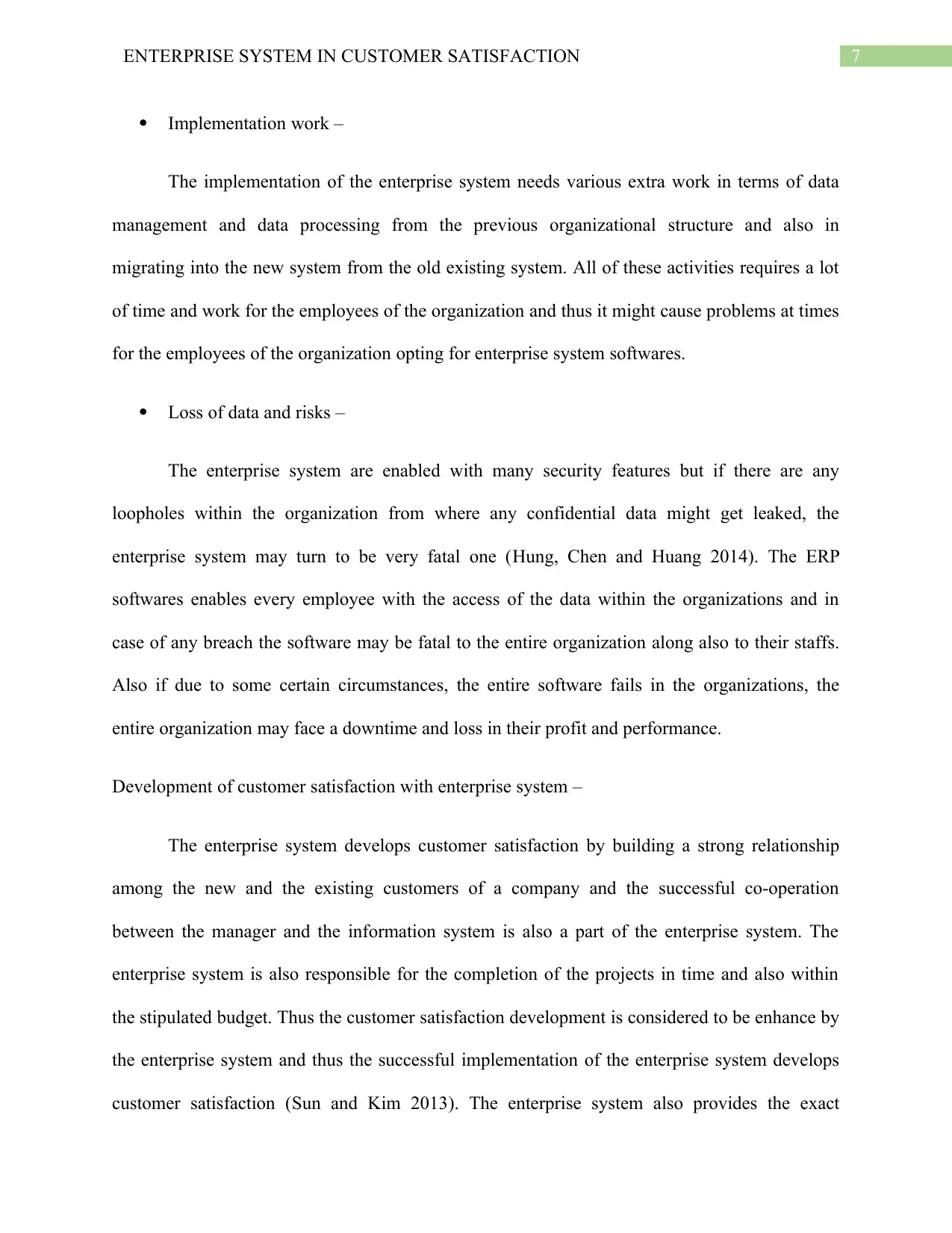
7ENTERPRISE SYSTEM IN CUSTOMER SATISFACTION
Implementation work –
The implementation of the enterprise system needs various extra work in terms of data
management and data processing from the previous organizational structure and also in
migrating into the new system from the old existing system. All of these activities requires a lot
of time and work for the employees of the organization and thus it might cause problems at times
for the employees of the organization opting for enterprise system softwares.
Loss of data and risks –
The enterprise system are enabled with many security features but if there are any
loopholes within the organization from where any confidential data might get leaked, the
enterprise system may turn to be very fatal one (Hung, Chen and Huang 2014). The ERP
softwares enables every employee with the access of the data within the organizations and in
case of any breach the software may be fatal to the entire organization along also to their staffs.
Also if due to some certain circumstances, the entire software fails in the organizations, the
entire organization may face a downtime and loss in their profit and performance.
Development of customer satisfaction with enterprise system –
The enterprise system develops customer satisfaction by building a strong relationship
among the new and the existing customers of a company and the successful co-operation
between the manager and the information system is also a part of the enterprise system. The
enterprise system is also responsible for the completion of the projects in time and also within
the stipulated budget. Thus the customer satisfaction development is considered to be enhance by
the enterprise system and thus the successful implementation of the enterprise system develops
customer satisfaction (Sun and Kim 2013). The enterprise system also provides the exact
Implementation work –
The implementation of the enterprise system needs various extra work in terms of data
management and data processing from the previous organizational structure and also in
migrating into the new system from the old existing system. All of these activities requires a lot
of time and work for the employees of the organization and thus it might cause problems at times
for the employees of the organization opting for enterprise system softwares.
Loss of data and risks –
The enterprise system are enabled with many security features but if there are any
loopholes within the organization from where any confidential data might get leaked, the
enterprise system may turn to be very fatal one (Hung, Chen and Huang 2014). The ERP
softwares enables every employee with the access of the data within the organizations and in
case of any breach the software may be fatal to the entire organization along also to their staffs.
Also if due to some certain circumstances, the entire software fails in the organizations, the
entire organization may face a downtime and loss in their profit and performance.
Development of customer satisfaction with enterprise system –
The enterprise system develops customer satisfaction by building a strong relationship
among the new and the existing customers of a company and the successful co-operation
between the manager and the information system is also a part of the enterprise system. The
enterprise system is also responsible for the completion of the projects in time and also within
the stipulated budget. Thus the customer satisfaction development is considered to be enhance by
the enterprise system and thus the successful implementation of the enterprise system develops
customer satisfaction (Sun and Kim 2013). The enterprise system also provides the exact
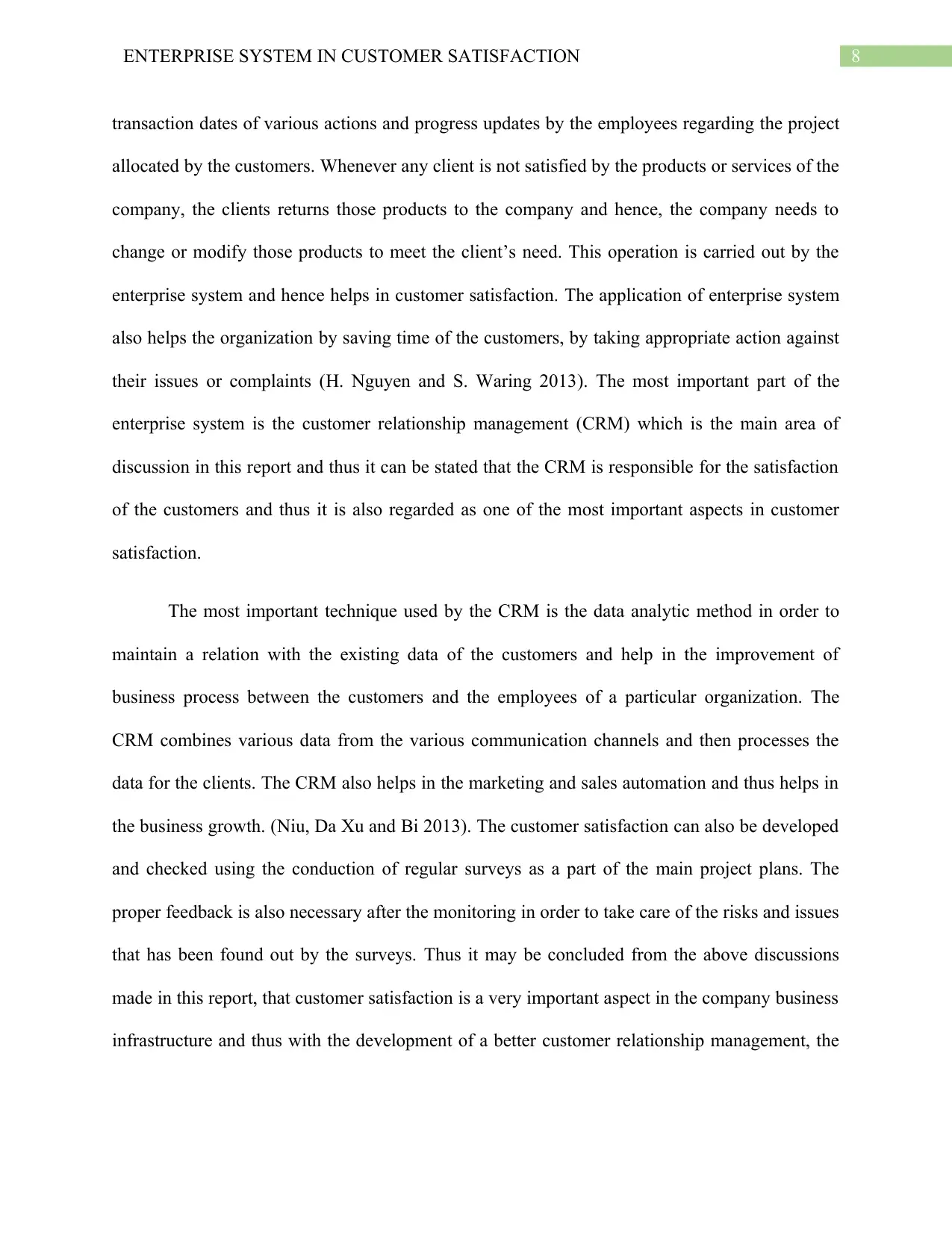
8ENTERPRISE SYSTEM IN CUSTOMER SATISFACTION
transaction dates of various actions and progress updates by the employees regarding the project
allocated by the customers. Whenever any client is not satisfied by the products or services of the
company, the clients returns those products to the company and hence, the company needs to
change or modify those products to meet the client’s need. This operation is carried out by the
enterprise system and hence helps in customer satisfaction. The application of enterprise system
also helps the organization by saving time of the customers, by taking appropriate action against
their issues or complaints (H. Nguyen and S. Waring 2013). The most important part of the
enterprise system is the customer relationship management (CRM) which is the main area of
discussion in this report and thus it can be stated that the CRM is responsible for the satisfaction
of the customers and thus it is also regarded as one of the most important aspects in customer
satisfaction.
The most important technique used by the CRM is the data analytic method in order to
maintain a relation with the existing data of the customers and help in the improvement of
business process between the customers and the employees of a particular organization. The
CRM combines various data from the various communication channels and then processes the
data for the clients. The CRM also helps in the marketing and sales automation and thus helps in
the business growth. (Niu, Da Xu and Bi 2013). The customer satisfaction can also be developed
and checked using the conduction of regular surveys as a part of the main project plans. The
proper feedback is also necessary after the monitoring in order to take care of the risks and issues
that has been found out by the surveys. Thus it may be concluded from the above discussions
made in this report, that customer satisfaction is a very important aspect in the company business
infrastructure and thus with the development of a better customer relationship management, the
transaction dates of various actions and progress updates by the employees regarding the project
allocated by the customers. Whenever any client is not satisfied by the products or services of the
company, the clients returns those products to the company and hence, the company needs to
change or modify those products to meet the client’s need. This operation is carried out by the
enterprise system and hence helps in customer satisfaction. The application of enterprise system
also helps the organization by saving time of the customers, by taking appropriate action against
their issues or complaints (H. Nguyen and S. Waring 2013). The most important part of the
enterprise system is the customer relationship management (CRM) which is the main area of
discussion in this report and thus it can be stated that the CRM is responsible for the satisfaction
of the customers and thus it is also regarded as one of the most important aspects in customer
satisfaction.
The most important technique used by the CRM is the data analytic method in order to
maintain a relation with the existing data of the customers and help in the improvement of
business process between the customers and the employees of a particular organization. The
CRM combines various data from the various communication channels and then processes the
data for the clients. The CRM also helps in the marketing and sales automation and thus helps in
the business growth. (Niu, Da Xu and Bi 2013). The customer satisfaction can also be developed
and checked using the conduction of regular surveys as a part of the main project plans. The
proper feedback is also necessary after the monitoring in order to take care of the risks and issues
that has been found out by the surveys. Thus it may be concluded from the above discussions
made in this report, that customer satisfaction is a very important aspect in the company business
infrastructure and thus with the development of a better customer relationship management, the
⊘ This is a preview!⊘
Do you want full access?
Subscribe today to unlock all pages.

Trusted by 1+ million students worldwide
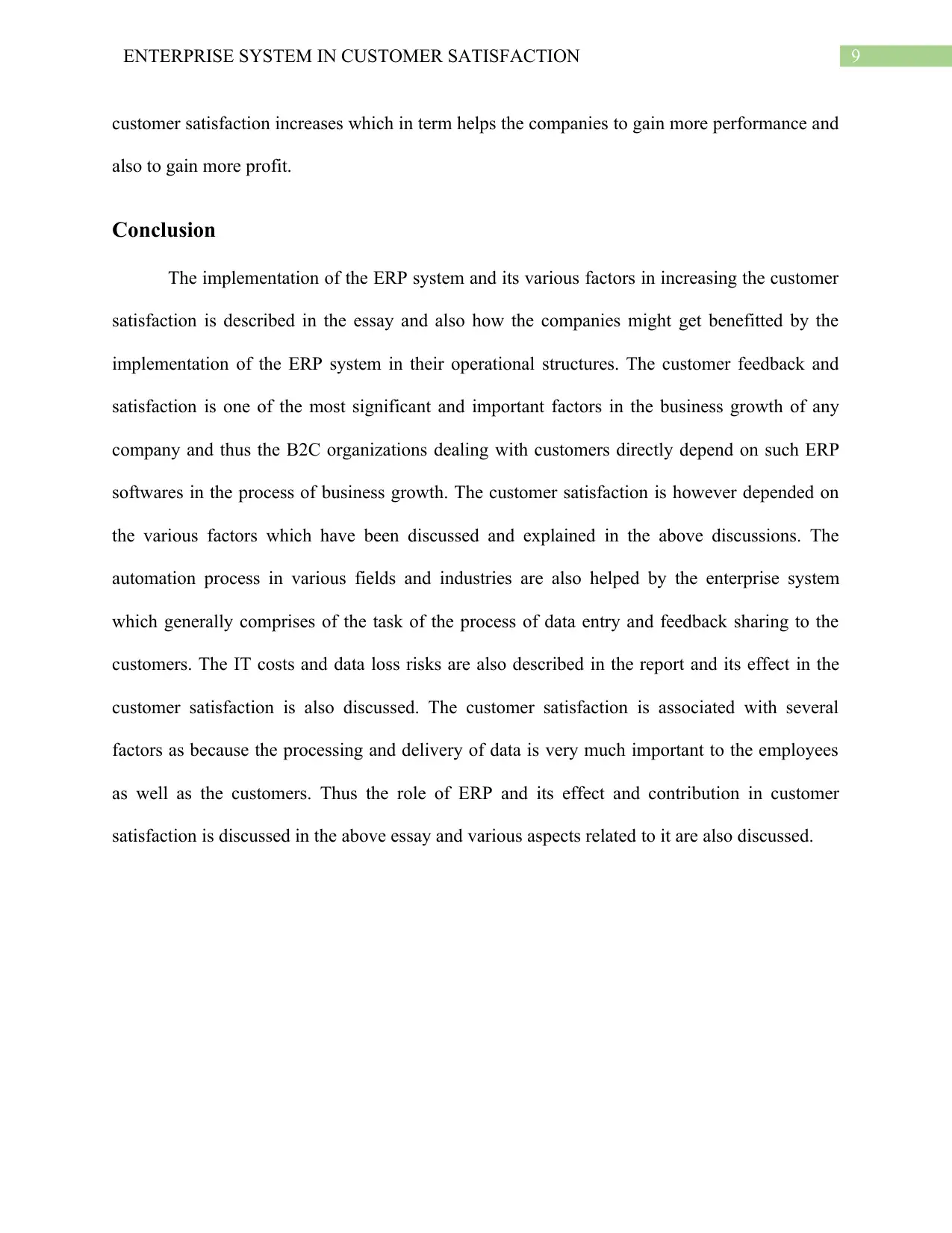
9ENTERPRISE SYSTEM IN CUSTOMER SATISFACTION
customer satisfaction increases which in term helps the companies to gain more performance and
also to gain more profit.
Conclusion
The implementation of the ERP system and its various factors in increasing the customer
satisfaction is described in the essay and also how the companies might get benefitted by the
implementation of the ERP system in their operational structures. The customer feedback and
satisfaction is one of the most significant and important factors in the business growth of any
company and thus the B2C organizations dealing with customers directly depend on such ERP
softwares in the process of business growth. The customer satisfaction is however depended on
the various factors which have been discussed and explained in the above discussions. The
automation process in various fields and industries are also helped by the enterprise system
which generally comprises of the task of the process of data entry and feedback sharing to the
customers. The IT costs and data loss risks are also described in the report and its effect in the
customer satisfaction is also discussed. The customer satisfaction is associated with several
factors as because the processing and delivery of data is very much important to the employees
as well as the customers. Thus the role of ERP and its effect and contribution in customer
satisfaction is discussed in the above essay and various aspects related to it are also discussed.
customer satisfaction increases which in term helps the companies to gain more performance and
also to gain more profit.
Conclusion
The implementation of the ERP system and its various factors in increasing the customer
satisfaction is described in the essay and also how the companies might get benefitted by the
implementation of the ERP system in their operational structures. The customer feedback and
satisfaction is one of the most significant and important factors in the business growth of any
company and thus the B2C organizations dealing with customers directly depend on such ERP
softwares in the process of business growth. The customer satisfaction is however depended on
the various factors which have been discussed and explained in the above discussions. The
automation process in various fields and industries are also helped by the enterprise system
which generally comprises of the task of the process of data entry and feedback sharing to the
customers. The IT costs and data loss risks are also described in the report and its effect in the
customer satisfaction is also discussed. The customer satisfaction is associated with several
factors as because the processing and delivery of data is very much important to the employees
as well as the customers. Thus the role of ERP and its effect and contribution in customer
satisfaction is discussed in the above essay and various aspects related to it are also discussed.
Paraphrase This Document
Need a fresh take? Get an instant paraphrase of this document with our AI Paraphraser
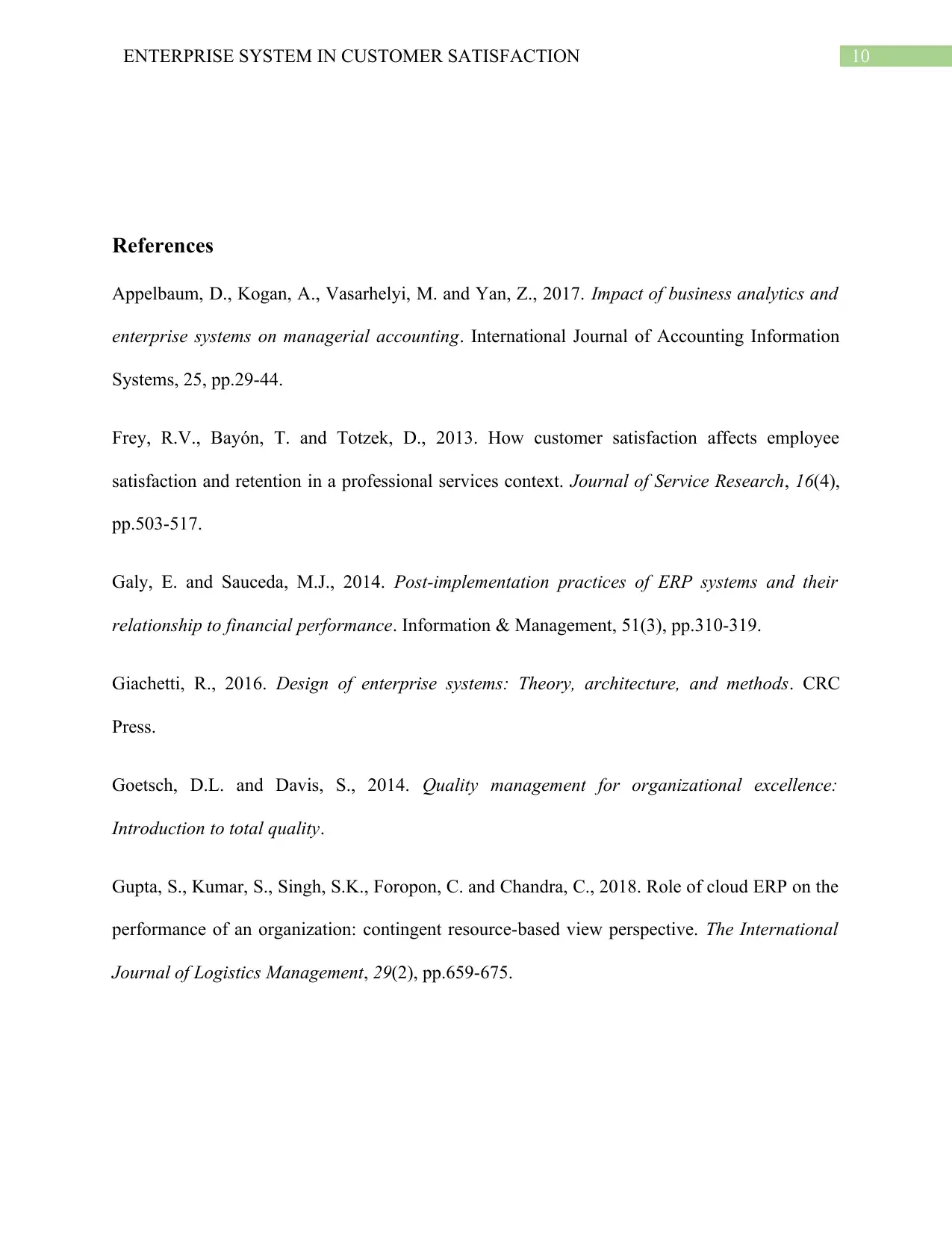
10ENTERPRISE SYSTEM IN CUSTOMER SATISFACTION
References
Appelbaum, D., Kogan, A., Vasarhelyi, M. and Yan, Z., 2017. Impact of business analytics and
enterprise systems on managerial accounting. International Journal of Accounting Information
Systems, 25, pp.29-44.
Frey, R.V., Bayón, T. and Totzek, D., 2013. How customer satisfaction affects employee
satisfaction and retention in a professional services context. Journal of Service Research, 16(4),
pp.503-517.
Galy, E. and Sauceda, M.J., 2014. Post-implementation practices of ERP systems and their
relationship to financial performance. Information & Management, 51(3), pp.310-319.
Giachetti, R., 2016. Design of enterprise systems: Theory, architecture, and methods. CRC
Press.
Goetsch, D.L. and Davis, S., 2014. Quality management for organizational excellence:
Introduction to total quality.
Gupta, S., Kumar, S., Singh, S.K., Foropon, C. and Chandra, C., 2018. Role of cloud ERP on the
performance of an organization: contingent resource-based view perspective. The International
Journal of Logistics Management, 29(2), pp.659-675.
References
Appelbaum, D., Kogan, A., Vasarhelyi, M. and Yan, Z., 2017. Impact of business analytics and
enterprise systems on managerial accounting. International Journal of Accounting Information
Systems, 25, pp.29-44.
Frey, R.V., Bayón, T. and Totzek, D., 2013. How customer satisfaction affects employee
satisfaction and retention in a professional services context. Journal of Service Research, 16(4),
pp.503-517.
Galy, E. and Sauceda, M.J., 2014. Post-implementation practices of ERP systems and their
relationship to financial performance. Information & Management, 51(3), pp.310-319.
Giachetti, R., 2016. Design of enterprise systems: Theory, architecture, and methods. CRC
Press.
Goetsch, D.L. and Davis, S., 2014. Quality management for organizational excellence:
Introduction to total quality.
Gupta, S., Kumar, S., Singh, S.K., Foropon, C. and Chandra, C., 2018. Role of cloud ERP on the
performance of an organization: contingent resource-based view perspective. The International
Journal of Logistics Management, 29(2), pp.659-675.
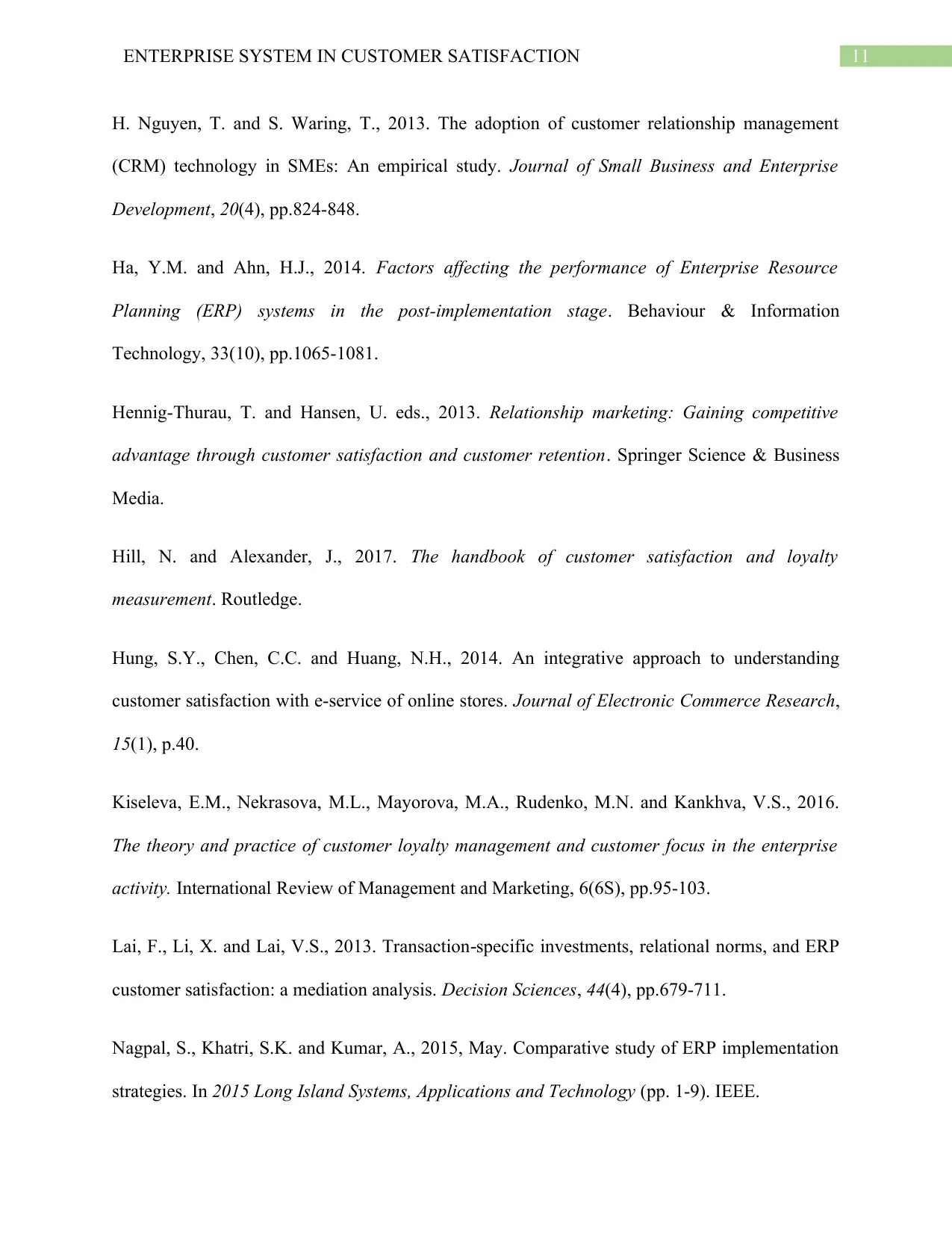
11ENTERPRISE SYSTEM IN CUSTOMER SATISFACTION
H. Nguyen, T. and S. Waring, T., 2013. The adoption of customer relationship management
(CRM) technology in SMEs: An empirical study. Journal of Small Business and Enterprise
Development, 20(4), pp.824-848.
Ha, Y.M. and Ahn, H.J., 2014. Factors affecting the performance of Enterprise Resource
Planning (ERP) systems in the post-implementation stage. Behaviour & Information
Technology, 33(10), pp.1065-1081.
Hennig-Thurau, T. and Hansen, U. eds., 2013. Relationship marketing: Gaining competitive
advantage through customer satisfaction and customer retention. Springer Science & Business
Media.
Hill, N. and Alexander, J., 2017. The handbook of customer satisfaction and loyalty
measurement. Routledge.
Hung, S.Y., Chen, C.C. and Huang, N.H., 2014. An integrative approach to understanding
customer satisfaction with e-service of online stores. Journal of Electronic Commerce Research,
15(1), p.40.
Kiseleva, E.M., Nekrasova, M.L., Mayorova, M.A., Rudenko, M.N. and Kankhva, V.S., 2016.
The theory and practice of customer loyalty management and customer focus in the enterprise
activity. International Review of Management and Marketing, 6(6S), pp.95-103.
Lai, F., Li, X. and Lai, V.S., 2013. Transaction specific investments, relational norms, and ERP‐
customer satisfaction: a mediation analysis. Decision Sciences, 44(4), pp.679-711.
Nagpal, S., Khatri, S.K. and Kumar, A., 2015, May. Comparative study of ERP implementation
strategies. In 2015 Long Island Systems, Applications and Technology (pp. 1-9). IEEE.
H. Nguyen, T. and S. Waring, T., 2013. The adoption of customer relationship management
(CRM) technology in SMEs: An empirical study. Journal of Small Business and Enterprise
Development, 20(4), pp.824-848.
Ha, Y.M. and Ahn, H.J., 2014. Factors affecting the performance of Enterprise Resource
Planning (ERP) systems in the post-implementation stage. Behaviour & Information
Technology, 33(10), pp.1065-1081.
Hennig-Thurau, T. and Hansen, U. eds., 2013. Relationship marketing: Gaining competitive
advantage through customer satisfaction and customer retention. Springer Science & Business
Media.
Hill, N. and Alexander, J., 2017. The handbook of customer satisfaction and loyalty
measurement. Routledge.
Hung, S.Y., Chen, C.C. and Huang, N.H., 2014. An integrative approach to understanding
customer satisfaction with e-service of online stores. Journal of Electronic Commerce Research,
15(1), p.40.
Kiseleva, E.M., Nekrasova, M.L., Mayorova, M.A., Rudenko, M.N. and Kankhva, V.S., 2016.
The theory and practice of customer loyalty management and customer focus in the enterprise
activity. International Review of Management and Marketing, 6(6S), pp.95-103.
Lai, F., Li, X. and Lai, V.S., 2013. Transaction specific investments, relational norms, and ERP‐
customer satisfaction: a mediation analysis. Decision Sciences, 44(4), pp.679-711.
Nagpal, S., Khatri, S.K. and Kumar, A., 2015, May. Comparative study of ERP implementation
strategies. In 2015 Long Island Systems, Applications and Technology (pp. 1-9). IEEE.
⊘ This is a preview!⊘
Do you want full access?
Subscribe today to unlock all pages.

Trusted by 1+ million students worldwide
1 out of 14
Related Documents
Your All-in-One AI-Powered Toolkit for Academic Success.
+13062052269
info@desklib.com
Available 24*7 on WhatsApp / Email
![[object Object]](/_next/static/media/star-bottom.7253800d.svg)
Unlock your academic potential
Copyright © 2020–2025 A2Z Services. All Rights Reserved. Developed and managed by ZUCOL.





